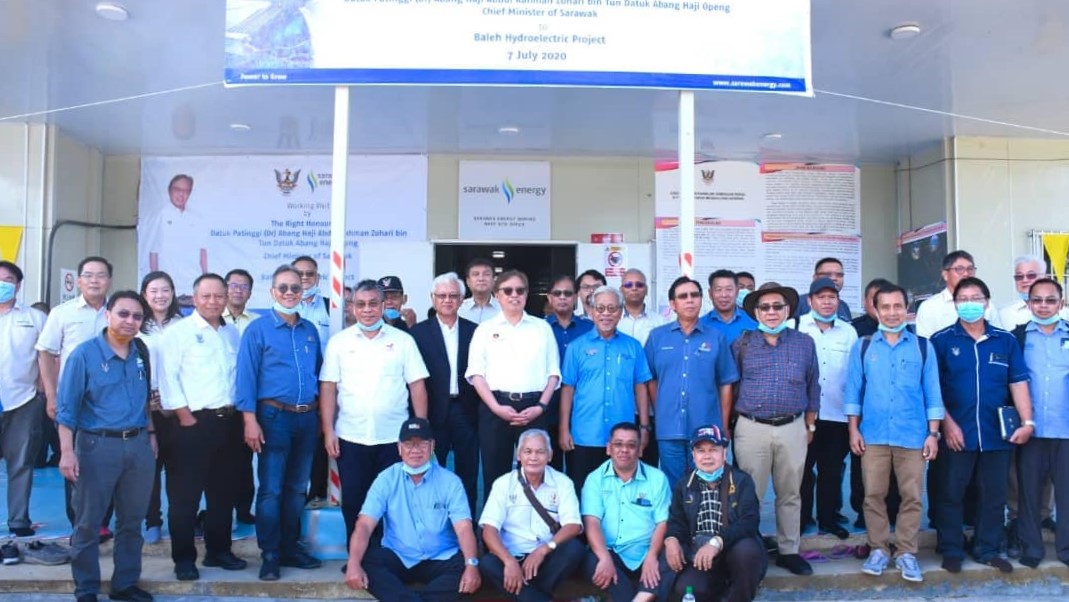JULAI 2020
Energy Key To Propel Sarawak’s Economy: CM

BALEH, JULY 7, TUESDAY: Energy for running industries encompassing the agricultural sector would be key to propel Sarawak’s economy towards 2030 and beyond, Chief Minister Datuk Patinggi Abang Haji Abdul Rahman Zohari Tun Datuk Abang Haji Openg said here today.
With the takeover of Bakun HEP from the federal government and power generation from the Batang Ai, Murum and later Baleh dams the state would have complete control over its power production, he said in his return remark after being briefed on the progress of Baleh HEP at the project site in Ulu Baleh.
Having the ease of control would enable the state to determine its power tariff and thus the ease to devise incentives to attract foreign investment, he pointed out.
This was his first visit to the project site to have a first hand view of one of Sarawak’s largest strategic infrastructure development project which when commissioned, will boost renewable hydropower generation and energy security for Sarawak.
Accompanying the Chief Minister were Tan Sri Datuk Amar James Jemut Masing, Sarawak Deputy Chief Minister, Dato Sri Dr Stephen Rundi Utom, Sarawak Minister for Utilities, Datuk Amar Jaul Samion, State Secretary, and Datuk Wilson Ugak Kumbong, Member of Parliament for Hulu Rajang. They were received by Sarawak Energy Chairman Datuk Amar Abdul Hamed Sepawi and Datu Haji Sharbini Suhaili, Group Chief Executive Officer.
Prior to his arrival at project site, Johari flew over Baleh HEP for an aerial view of the progress of the civil works for the main dam including the construction of the tunnel portal diversion, which is a significant part of the works package.
This was followed by a presentation by Baleh HEP Project Director Tan Hang Kiak on the milestones in the management of the project.
The Chief Minister pointed out that Sarawak’s future for sustainable energy security lies in hydropower generation.
Baleh HEP is our largest civil works project by a Sarawak Government owned company and will serve as an additional milestones in the renewable energy and development strategy of Sarawak.
“Once Baleh HEP is fully commissioned by 2026, we will have sufficient energy to cater to the anticipated rapid growth in organic and industrial demand for electricity as we progress in our ambition to become a high income economy by 2030,” he said.
“Baleh HEP when commissioned will join Sarawak’s stable of hydropower plants that includes Batang Ai, Murum and Bakun and strengthen our aspiration to become a regional powerhouse of renewable and affordable energy.
He gave assurance that the government would ensure that people in the locality would stand to enjoy the benefits of being near to the source of power with stepdown facilities in order to have supply of power to their homes and cater to needs of agriculture.
“We have learnt from our mistakes such as in Batang Ai where people in the immediate vicinity of the dam were bypassed by the power supply,” he added.
Meanwhile Rundi said, “Baleh HEP is crucial in securing the energy capacity needed for the development of Sarawak. While we may have sufficient power for now, we need to plan and prepare for what is ahead of us in the future. Energy poverty is a major obstacle to prosperity and progress in other countries and we do not want to have this happen to Sarawak.”
Adding on, Hamed said, “Baleh HEP is a project to benefit all of Sarawak in the long run. We are doing our best to keep the project on track despite the set-backs we faced due to COVID19 and other challenges. We will need the support from all stakeholders to ensure the smooth execution of the project in order to meet our target project commissioning in 2026. Construction of Baleh HEP has now resumed at an accelerated speed,” he added.
Located on the Baleh River, about 105km upstream from the confluence with the Rejang River in Kapit, the 188m-high Concrete Faced Rockfill Baleh Dam is one of Sarawak’s largest infrastructure projects.
It is also the largest HEP developed by Sarawak Energy and will generate 1,285MW of renewable energy to the grid when it is fully commissioned by 2026.
All of Sarawak Energy’s hydropower dams are designed and constructed following stringent guidelines set by the International Commission on Large Dams (ICOLD) to withstand extreme flood events and is also in accordance with guidelines set out by the Hydropower Sustainability Assessment Protocol of the International Hydropower Association.- ENDS
Sumber dari : Sarawakku